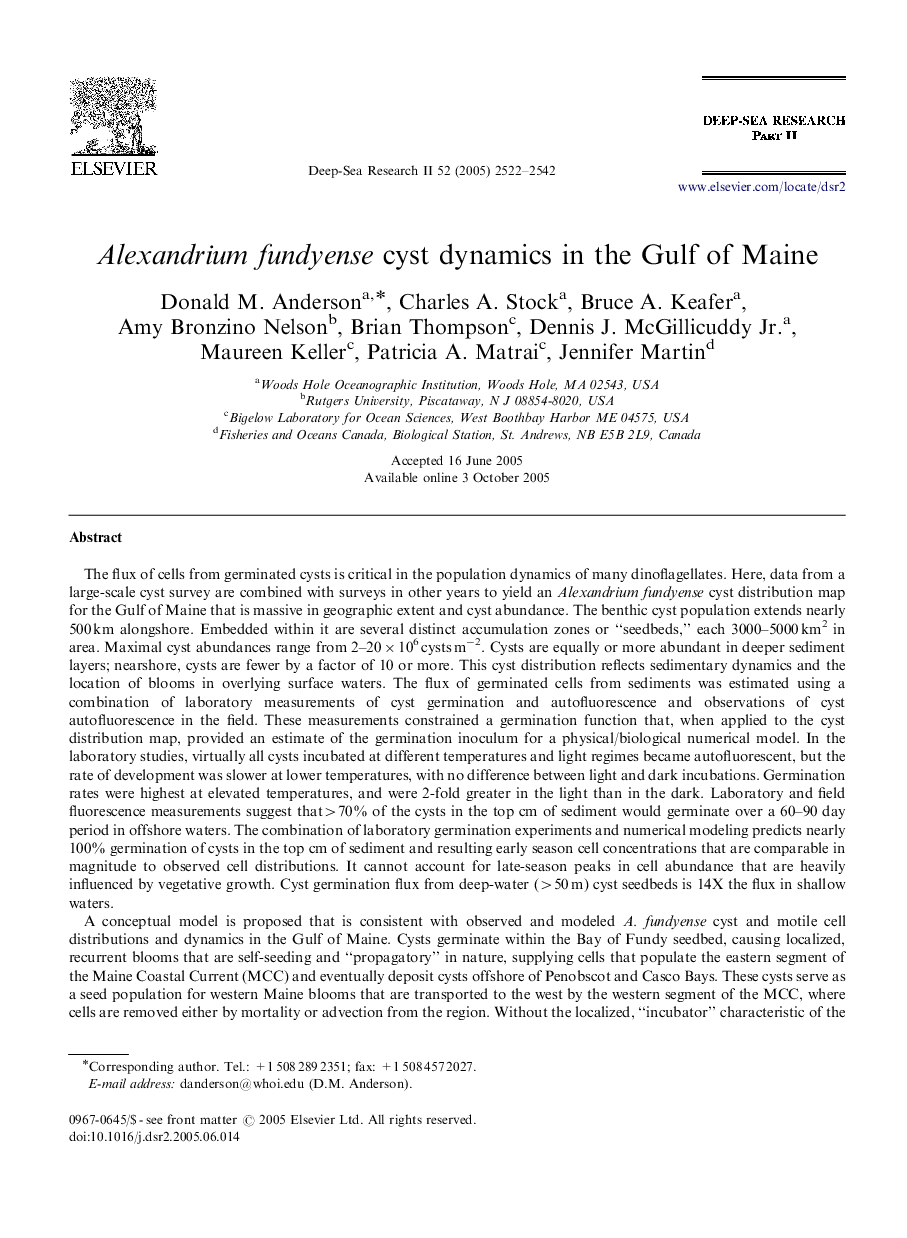| کد مقاله | کد نشریه | سال انتشار | مقاله انگلیسی | نسخه تمام متن |
|---|---|---|---|---|
| 4538581 | 1626522 | 2005 | 21 صفحه PDF | دانلود رایگان |

The flux of cells from germinated cysts is critical in the population dynamics of many dinoflagellates. Here, data from a large-scale cyst survey are combined with surveys in other years to yield an Alexandrium fundyense cyst distribution map for the Gulf of Maine that is massive in geographic extent and cyst abundance. The benthic cyst population extends nearly 500 km alongshore. Embedded within it are several distinct accumulation zones or “seedbeds,” each 3000–5000 km2 in area. Maximal cyst abundances range from 2–20×106 cysts m−2. Cysts are equally or more abundant in deeper sediment layers; nearshore, cysts are fewer by a factor of 10 or more. This cyst distribution reflects sedimentary dynamics and the location of blooms in overlying surface waters. The flux of germinated cells from sediments was estimated using a combination of laboratory measurements of cyst germination and autofluorescence and observations of cyst autofluorescence in the field. These measurements constrained a germination function that, when applied to the cyst distribution map, provided an estimate of the germination inoculum for a physical/biological numerical model. In the laboratory studies, virtually all cysts incubated at different temperatures and light regimes became autofluorescent, but the rate of development was slower at lower temperatures, with no difference between light and dark incubations. Germination rates were highest at elevated temperatures, and were 2-fold greater in the light than in the dark. Laboratory and field fluorescence measurements suggest that>70% of the cysts in the top cm of sediment would germinate over a 60–90 day period in offshore waters. The combination of laboratory germination experiments and numerical modeling predicts nearly 100% germination of cysts in the top cm of sediment and resulting early season cell concentrations that are comparable in magnitude to observed cell distributions. It cannot account for late-season peaks in cell abundance that are heavily influenced by vegetative growth. Cyst germination flux from deep-water (>50 m) cyst seedbeds is 14X the flux in shallow waters.A conceptual model is proposed that is consistent with observed and modeled A. fundyense cyst and motile cell distributions and dynamics in the Gulf of Maine. Cysts germinate within the Bay of Fundy seedbed, causing localized, recurrent blooms that are self-seeding and “propagatory” in nature, supplying cells that populate the eastern segment of the Maine Coastal Current (MCC) and eventually deposit cysts offshore of Penobscot and Casco Bays. These cysts serve as a seed population for western Maine blooms that are transported to the west by the western segment of the MCC, where cells are removed either by mortality or advection from the region. Without the localized, “incubator” characteristic of the Bay of Fundy bloom zone, A. fundyense populations in the Gulf of Maine should diminish through time. Their persistence over many decades highlights the effectiveness of the mechanisms described here.
Journal: Deep Sea Research Part II: Topical Studies in Oceanography - Volume 52, Issues 19–21, September–October 2005, Pages 2522–2542